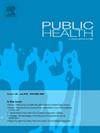贫困、孤独与以疼痛、疲劳和情绪低落为特征的防御性症状群之间的关系
IF 3.2
3区 医学
Q1 PUBLIC, ENVIRONMENTAL & OCCUPATIONAL HEALTH
引用次数: 0
摘要
感知到的社会孤立与疼痛、疲劳和抑郁增加有关。其他研究表明,疼痛和抑郁在社会经济地位较低的个体中更为常见,而社会关系对于缓冲社会经济地位低下对健康的负面影响尤为重要。研究designCross-sectional。方法我们使用了20个国家的24,504名欧洲社会调查7的受访者的横断面样本。使用多水平线性回归来检验孤独、收入十分位数及其相互作用对症状类变量的影响,该变量是受访者自我报告的疼痛、疲劳和情绪低落的z分数的平均值。我们假设孤独和低收入会与较高的症状群得分相互关联。结果来自低收入十分位数的学生更容易感到孤独(最低收入十分位数为48.7%;在收入最高的10%中占15.2%),尽管在社交上花费的时间没有差异。多水平线性回归显示,与我们的假设相一致的统计显著相关性:(1)孤独个体在症状类上的得分高0.447 SD,(2)收入每增加十分位数,症状类得分降低0.022 SD,(3)孤独与收入在症状类上的相互作用(b = - 0.018),在收入较低的十分位数中,孤独与症状类之间的相关性最强。结论孤独感和低收入都与症状类得分相关,而社会关系对贫困个体的症状类得分有较强的缓冲作用。结果为理解健康的社会和经济梯度提供了信息。本文章由计算机程序翻译,如有差异,请以英文原文为准。
Associations amongst poverty, loneliness, and a defensive symptom cluster characterised by pain, fatigue, and low mood
Objective
Perceived social isolation is associated with increased pain, fatigue, and depression. Other research has shown that pain and depression are more common in individuals experiencing low socio-economic status, and that social relationships are especially important for buffering the negative health effects of low socio-economic status.
Study design
Cross-sectional.
Methods
We used a 20-country, cross-sectional sample of 24,504 respondents to the European Social Survey 7. Multilevel linear regression was used to test for the effects of loneliness, income decile, and their interaction on a symptom cluster variable that was the average of respondent z-scores on self-reported pain, fatigue, and low mood. We hypothesised that loneliness and low income would be interactively associated with higher symptom cluster scores.
Results
Those from lower income deciles were much more likely to feel lonely (48.7 % in the lowest income decile; 15.2 % in the highest income decile), despite no differences in reported time spent socialising. Multilevel linear regression indicated statistically significant associations consistent with our hypotheses: (1) lonely individuals score 0.447 SD higher on the symptom cluster, (2) for every increase in income decile, symptom cluster scores decrease by 0.022 SD, and (3) a loneliness by income interaction on the symptom cluster (b = −0.018), with the association between loneliness and the symptom cluster being strongest amongst those in lower income deciles.
Conclusions
Both loneliness and low income were associated with higher scores on the symptom cluster, and social relationships were especially strong buffers of the symptom cluster for individuals experiencing poverty. Results inform understandings of social and economic gradients in health.
求助全文
通过发布文献求助,成功后即可免费获取论文全文。
去求助
来源期刊

Public Health
医学-公共卫生、环境卫生与职业卫生
CiteScore
7.60
自引率
0.00%
发文量
280
审稿时长
37 days
期刊介绍:
Public Health is an international, multidisciplinary peer-reviewed journal. It publishes original papers, reviews and short reports on all aspects of the science, philosophy, and practice of public health.
 求助内容:
求助内容: 应助结果提醒方式:
应助结果提醒方式:


